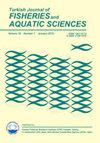Stock Assessment of Red Mullet, Mullus barbatus Linnaeus, 1758 by Length-based and Catch-based Models in the Northeastern Mediterranean
IF 1.7
4区 农林科学
Q3 FISHERIES
引用次数: 1
Abstract
Stock assessment for Mullus barbatus using catch-based (CMSY) and length based (LBB, LBSPR and LIME) data limited models were performed by using official catch statistics and commercial length frequency data from northeastern Mediterranean. The CMSY model results showed that the catch amount did not exceed MSY, and the fisheries reference points (B/BMSY and F/FMSY) indicated a healthy stock status in 2020. The LBB model results indicated that the biomass ratio was above safe biological limits (B<0.5 BMSY) but fishing mortality was slightly higher than natural mortality. Likewise, LBSPR results showed that SL50 for red mullet was higher than its Lm50, while the estimated median SPR was above the limit of 20% set as the biological reference point. The LIME results were more optimistic than those from the LBB and LBSPR and the estimated SPR was found above 40% which is the target reference point for a sustainable stock. According to the results of different assessment models, the red mullet stock was deemed sustainable in terms of biomass but observation of fishing pressure is required.地中海东北部红鲻鱼,Mullus barbatus Linnaeus, 1758年的种群评估——基于长度和基于捕捞量的模型
利用官方渔获量统计数据和地中海东北部的商业长度频率数据,使用基于渔获量(CMSY)和基于长度(LBB、LBSPR和LIME)的数据有限模型对斑刺Mullus种群进行了评估。CMSY模型结果显示,捕捞量没有超过MSY,渔业参考点(B/BMSY和F/FMSY)表明2020年种群状况良好。LBB模型结果表明,生物量比高于安全生物极限(B<0.5BMSY),但捕捞死亡率略高于自然死亡率。同样,LBSPR结果显示,红乌鱼的SL50高于其Lm50,而估计的SPR中值高于设定为生物参考点的20%的极限。LIME的结果比LBB和LBSPR的结果更乐观,估计的SPR高于40%,这是可持续库存的目标参考点。根据不同评估模型的结果,红乌鱼种群的生物量被认为是可持续的,但需要观察捕捞压力。
本文章由计算机程序翻译,如有差异,请以英文原文为准。
求助全文
约1分钟内获得全文
求助全文
来源期刊

Turkish Journal of Fisheries and Aquatic Sciences
FISHERIES-MARINE & FRESHWATER BIOLOGY
CiteScore
3.10
自引率
0.00%
发文量
43
审稿时长
3 months
期刊介绍:
Turkish Journal of Fisheries and Aquatic Sciences" (TrJFAS) is a refereed academic journal has been published by Central Fisheries Research Institute of Turkey and Japan International Cooperation Agency (JICA), and published in English.
It aims to address research and needs of all working and studying within the many varied areas of fisheries and aquatic sciences.
The Journal publishes English language original research papers, critical review articles, short communications and technical notes on applied or scientific research relevant to freshwater, brackish and marine environments.
TrJFAS was published biannually (April & November) between 2001 and 2009. A great number of manuscripts have been submitted to the journal for review from acceptance of the SCI index. Thereby, the journal has been published quarterly (March, June, September and December) from 2010 to 2017. The journal will be published monthly in 2018.
 求助内容:
求助内容: 应助结果提醒方式:
应助结果提醒方式:


